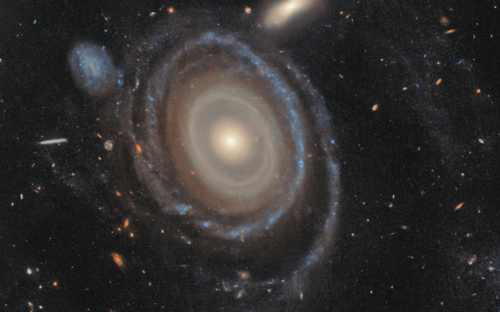Just as an organism’s anatomy reflects its evolutionary history, a galaxy’s morphology is dictated by its past environmental interactions. Collisional ring galaxies have a particularly striking shape, characterized by a bright core encircled by diffuse rings. However, these brilliant rings can only be produced by rare circumstances: two galaxies with a specific mass ratio must undergo a head-on collision, each passing quickly through the other’s center.
Recently, in the Astrophysical Journal Letters, Yale-led astronomers published the newly identified LEDA 1313424 as a collisional ring galaxy with a record number of nine concentric rings. By combining images from the Hubble Space Telescope, the Keck Telescope, and the Dragonfly Telescope Array, the group was able to confirm each of the rings and fondly nicknamed the object the “Bullseye” galaxy. “The observation of these clear ring structures confirmed for the first time the accuracy of analytic theory describing how these rings should look,” Imad Pasha GSAS ’24, lead author of the paper. Their data is precise enough that they plan to model the original collision that triggered the formation of these rings.
The detailed structure of the “Bullseye” galaxy also reveals insights into the properties of dark matter, the non-luminous component of the Universe. All galaxies are surrounded by a halo of dark matter whose extent is normally much larger than that of luminous stellar matter. The rings of the Bullseye galaxy, however, extend to over two hundred thousand light years, more than twice the width of the Milky Way. Thus, these outer rings can serve as tracers of the gravitational influence of dark matter to estimate its distribution around the galaxy. As observational surveys of the night sky continue, astronomers are hopeful for more serendipitous cosmic interactions, strengthening our understanding of the variety of matter and shapes present in the Universe.

